The Only 5 Gym Machines You Need (Plus 3 You Should Avoid)
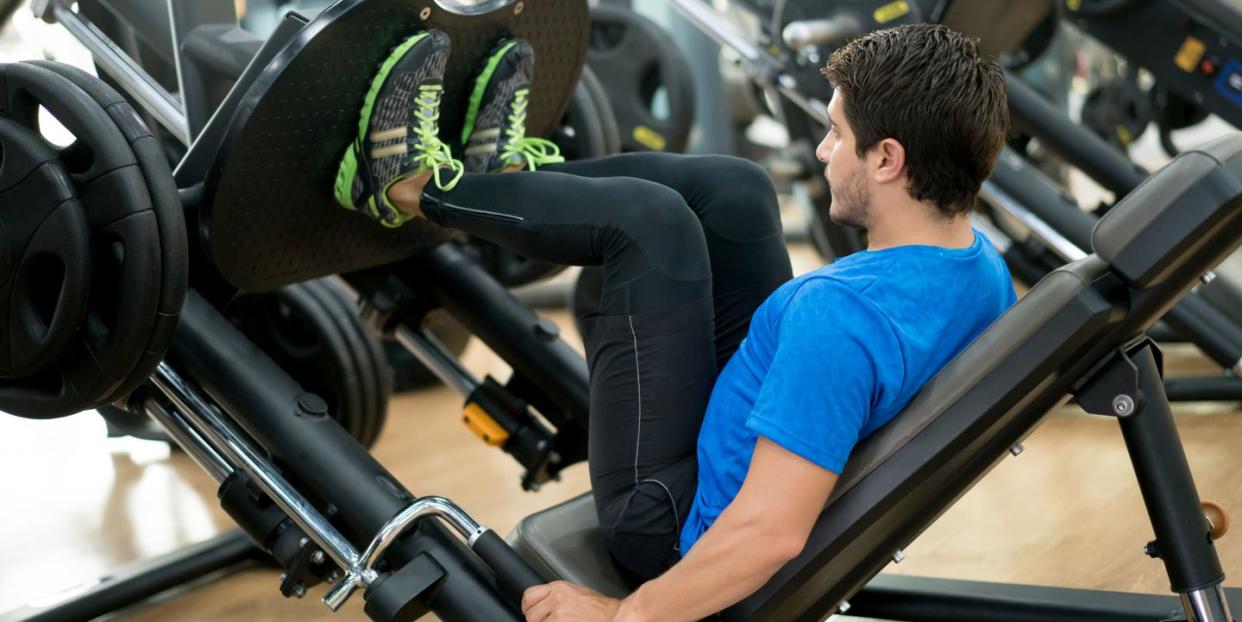
Walking into a gym can be a bit like a trip to Costco: You have a pretty good idea of what you want, but when you get there, all you see is a sea of shiny objects, and you suddenly have no idea what to do.
We get it—the gym floor can be overwhelming and intimidating. But it doesn’t have to be that way. The reality is that as a cyclist, you only need a handful of machines to complement your regular riding and free-weight routine to build cycling-specific strength, says Menachem Brodie, certified strength and conditioning specialist and founder of Human Vortex Training.
Below, Brodie shares the best weight machines that cyclists specifically will benefit from using. “These machines can be a useful and even fun addition to a barbell and free weight program,” he says. To make approaching the gym floor easier and less intimidating, here’s what he recommends and which machines he says to avoid.
The Best Weight Machines for Cyclists
Abductor/Adductor Machine
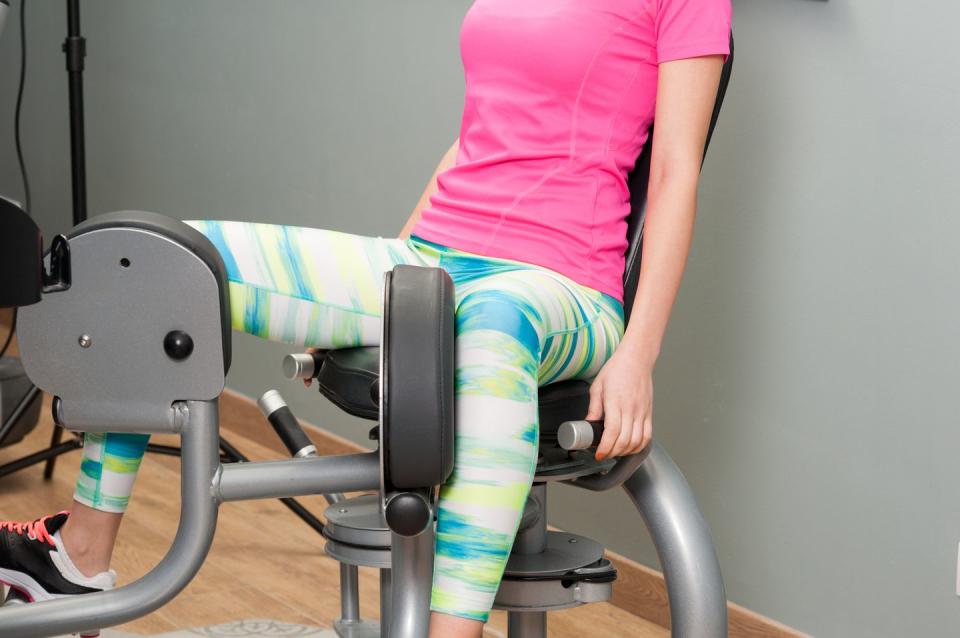
Pedaling a bike is largely a “two-dimensional” movement performed in the sagittal (front-to-back) plane. That means we spend a lot of time doing flexion and extension in the hips, knees, and ankles, while largely neglecting the muscles that move us from side-to-side. That’s a mistake because those lateral muscles help stabilize us in the saddle so we don’t waste a single watt (or succumb to injury).
The abductor/adductor machine works those lateral muscles. When you push your legs outward (abduction), you’re strengthening the hip abductors, including the outer glutes. When you press your legs inward (adduction), you’re strengthening the small muscles on the inside of the thigh, which help stabilize your pelvis (if you’ve ever had wicked inner thigh cramps after a hard ride or race, you know those muscles are hard at work when you’re cycling).
To target the abductors, place your legs inside the pads and press outward against them. Then adjust the machine and position your legs on the outside of the pads. Press into the pads to bring your legs together to work your adductor muscles.
Seated Reverse Fly
Hours spent hovering over computer keyboards (and then handlebars) can cause you to hunch, slouch, and round your shoulders over time. That’s bad for your posture and back health. The seated reverse or rear delt fly machine strengthens those muscles and de-slumps your posture. Because it engages your mid and lower trapezius muscles, rhomboids, and other small muscles in your upper back, all of which stabilize your shoulders and help prop you up as you’re pedaling away, you’ll be able to ride longer without upper back and neck fatigue as well.
Sit facing the machine, feet firmly on the ground, chest pressed against the chest pad and back straight. Grasp the horizontal handles. Keeping a slight bend in your elbows, contract your rear deltoids and trapezius muscles and slide your shoulder blades towards your spine while bringing your arms back until they are in line with your shoulders. Return to start.
Hack Squat

It’s hard to beat the hack squat machine for building monster quad strength. By stabilizing your back (which also removes the compressive load off your spine because of the angle of the sled) and placing the weight directly on your shoulders, your quads become the key drivers for pushing the weight. It doesn’t replace deadlifts, lunges, or other free weight lower-body lifts, but it’s way better than the leg extension machine for honing in on your quadriceps muscles, which are the primary mover in your pedal stroke.
When positioning yourself in the machine be sure that your feet are placed sufficiently in front of your body so that your shins are vertical and your thighs are horizontal to form a 90-degree angle in the bottom position. That avoids placing undue stress on your knees.
Leg Press
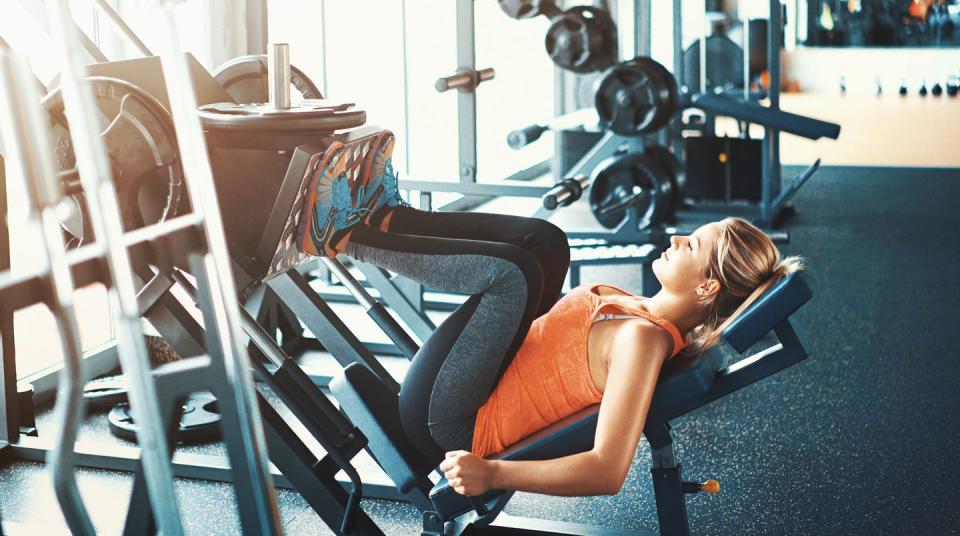
This exercise pops up again and again in cycling programs because it mirrors what we do on the bike as we push down on the pedals against resistance. It works your quads, glutes, and hamstrings without putting unnatural compressive forces on the spine the way exercises like back squats can, says Andrew Pruitt, Ed.D., the founder of the Boulder Center for Sports Medicine and CU Sports Medicine and Performance Center.
Sit in a vertical leg-press machine with your feet positioned about the same distance apart as they are on the bike. Lower the sled so your legs are bent at a 90-degree angle (never more). Slowly push the platform away without locking out your knees. Keeping feet flat against the platform, slowly lower to starting position.
Cable Crossover Machine
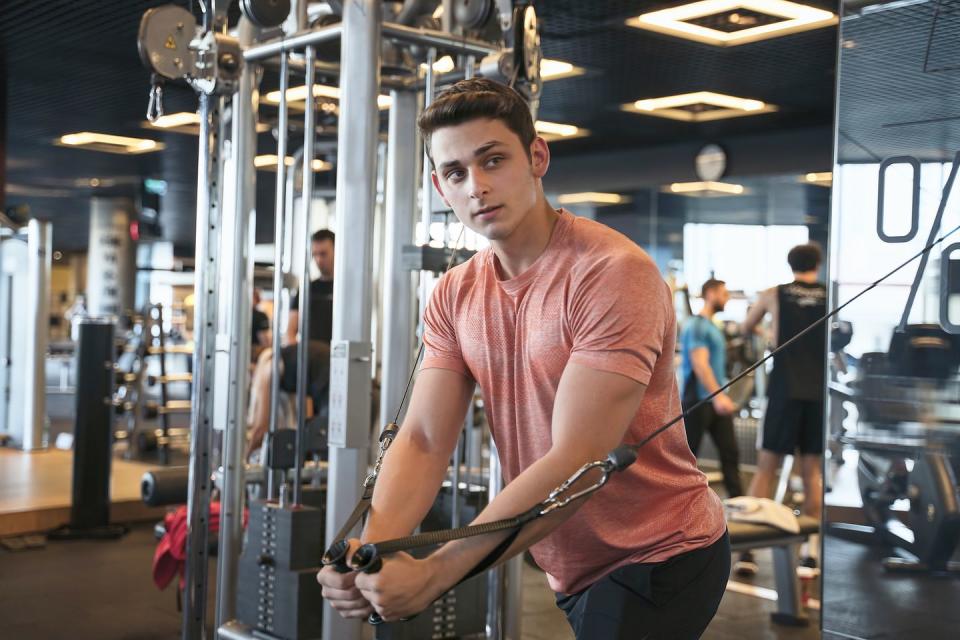
This is the jack-of-all-trades in the gym (it may also be super popular and hard to get time on). But if you snag it, you can perform any number of cycling-supportive exercises like the triceps press down and seated row.
Triceps press down: Your triceps—a three headed muscle along the back of your arm—supports the weight of your torso as you cruise down the road, especially if you favor the drops. Attach a rope handle to the high pulley on the cable machine. Keeping your elbows tucked in, grab the handle, contract your core, and press your hands down until your arms are fully extended, then return to the starting position. Only your forearms should move.
Seated row: Develops strength for pulling on the bars during sprints and on climbs as well as for negotiating obstacles off-road. Sit at the machine, with feet on the platforms, knees slightly bent. Grab the handle with arms extended straight in front of you. Sit up tall with your core engaged. With back straight, shoulders back, and chest up, bend your elbows to pull the handle toward your chest, bringing shoulder blades toward your spine. Return to starting position.
Weight Machines You Can Skip
Though these machines are popular with cyclists, they’re really not very functional for building cycling strength, Brodie says. Skip them and do moves that directly build cycling strength like squats and deadlifts instead.
Hamstring Curl
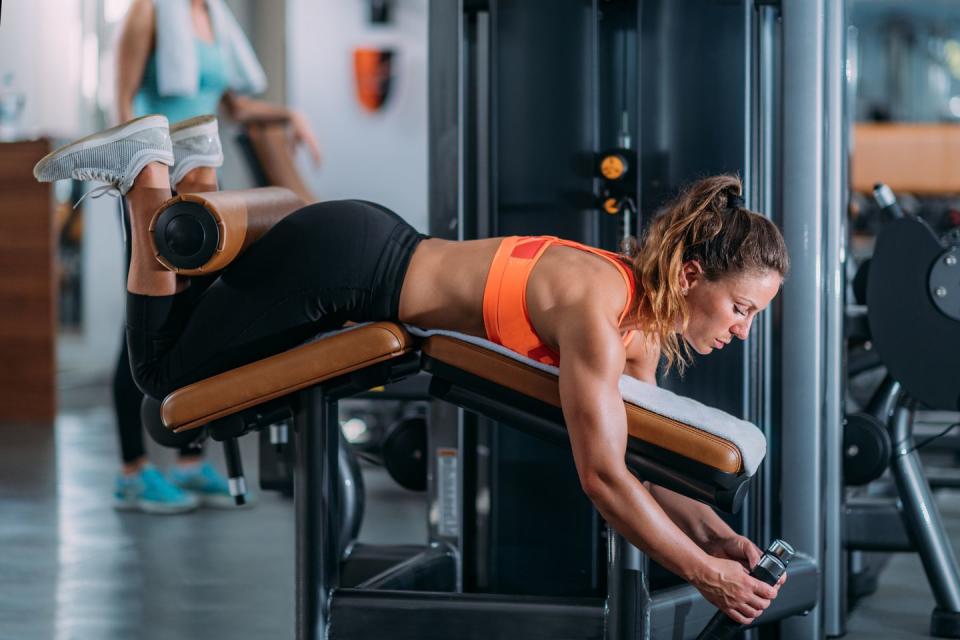
“I’m not a fan of the prone hamstring curl for cyclists,” Brodie says. “It puts you in a bad position where your midsection isn’t firing and the hips pop up, and it isn’t functional. There’s no reason to do it, though cyclists sometimes gravitate toward it because they think it will strengthen their ‘pulling’ muscles.” The single-leg deadlift is a better way to go.
Leg Extension

Unless you’re rehabbing an injury, there’s no reason to spend time on this machine. It’s a vanity machine with no cycling-specific functional benefits. “The elevated split squat [also known as Bulgarian squat] is a better way to go,” Brodie says.
Russian Twist
This machine has been popular with cyclists who want to strengthen every element of their core, but it can do more harm than good. You should avoid it at all costs as it has you twisting your legs against resistance while you sit facing forward. “It’s one of the fastest ways to delaminate your spine,” Brodie says, which can cause disc injury. It does no good and has the potential to do great harm. Steer clear.
You Might Also Like

